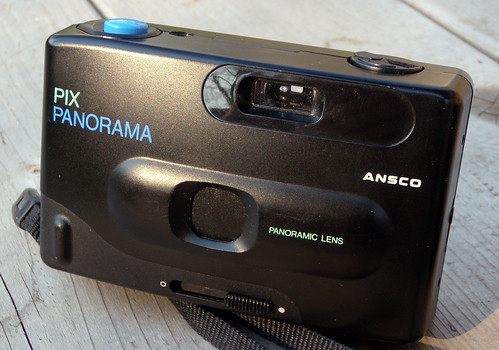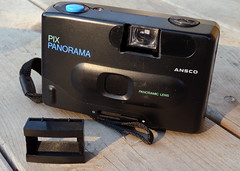Ansco Pix Panorama

|
| Ansco Pix Panorama by Voxphoto (Image rights) |
The Ansco Pix Panorama is an all-plastic, focus-free 35mm camera made in China[1]. Effectively a box camera, there are no exposure adjustments and no provision for flash.
The film gate in the camera is masked to only expose an image area approximately 13x36mm (rather than the conventional 24mm tall), typical for inexpensive 35mm panoramic cameras. This yields a "widescreen" aspect ratio of about 1:2.7 (which is greater than Cinemascope). Photofinishers were expected to enlarge this cropped negative into wider-than-standard panoramic prints: 89 x 254 mm or 3.5" x 10". This effectively doubles the amount of negative enlargement required (compared to standard 3:2 prints), with a resulting increase in the graininess of the image.
The Pix Panorama's lens has a focal length of approximately 27mm, and in contrast to other cameras in this class its two-element design offers reasonable sharpness.
A few Pix Panorama users discovered that the film-gate mask could be snapped out, and that its lens gives good coverage over the entire standard 24x36mm frame—although the viewfinder remained cropped to the panoramic format. However the front of the camera shell can be removed by loosening four small screws, revealing that the viewfinder optics themselves are the same ones used for conventional 3:2 proportions; so if desired, the viewfinder mask can be cut away.
The bottom of the Pix Panorama cites U.S. Patent 4,595,269[2], for a double-exposure prevention mechanism. This patent dates from 1986, and is assigned to Haking in Hong Kong. It seems likely Haking is the manufacturer of the Pix Panorama.

|
| Modifying the Pix Panorama for 3:2 aspect ratio by Voxphoto (Image rights) |
Notes
- ↑ A sample has also been seen labeled "Made in Thailand."
- ↑ (PDF) U.S. Patent 4,595,269 from Freepatentsonline.com.
Links
- Part I and part II of the Pix Panorama owners' manual. At the time of this manual's printing, the panoramic format was apparently unfamiliar to many photofinishers, and a sheet of self-stick labels was also included, to be pasted onto the film cassette to alert the lab about the special print size required.